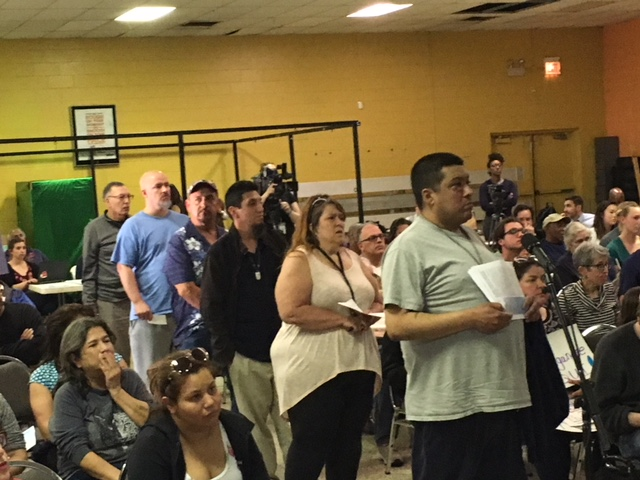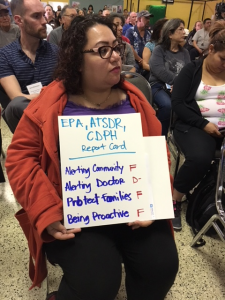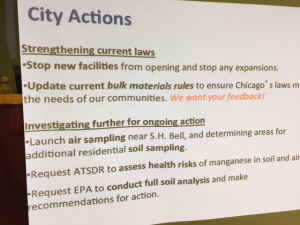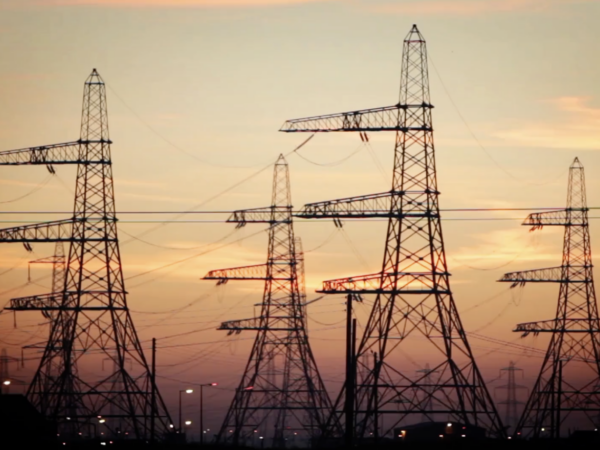
“We’re not invisible anymore”

Community meeting announcement. Photo by Gary Wilson
Frustrated with what they say is a lack of action by city and federal agencies in dealing with air quality issues, a coalition of Southeast Side Chicago community groups has called for a moratorium on the handling of manganese in their neighborhoods.
The group based its request on the release of data by the Chicago Department of Public Health (CDPH) that shows increased manganese contamination at homes near a plant that handles manganese.
Great Lakes Now previously reported on the manganese issue in January of this year as it was emerging. Chicago’s Southeast Side has also fought against storage of pet coke in its neighborhoods.
Exposure to large quantities of manganese can negatively impact the nervous system and children are especially vulnerable. . “The inhalation of a large quantity of dust or fumes containing manganese may cause irritation of the lungs which could lead to pneumonia,” according to the Agency for Toxic Substances and Disease Registry.
“We don’t have time to wait”

Southeast side Chicago resident gives failing grades to agencies responsible for air quality. Photo by Gary Wilson
In calling for the moratorium, the coalition said in a statement released by the Natural Resources Defense Council (NRDC) that “residents feel that government isn’t providing the proper protection and public health resources to families that continue to be exposed.”
The coalition wants testing expanded to parks where children play and schools plus additional homes. The group says “we don’t have time to wait” and asks that the moratorium be put in place immediately.
The demand comes on the heels of a public meeting conducted by the CDPH to brief the community on the status of its work on manganese. CDPH was joined by representatives of the U.S. Environmental Protection Agency and a unit (ATSDR) of the U.S. Department of Health and Human Services that specializes in toxic substances.
Presentations by representatives of the agencies to a packed room of concerned citizens focused on the process of their work — monitoring, testing and analyzing — not action items that would produce results
Expecting to hear about remedies not process, one resident yelled out during the formal presentations, “how long did you know about this? This is ridiculous.”
When the meeting opened up to questions and comments, residents were having none of the bureaucratic explanations.
Chicago Alderwoman Susan Sadlowski Garza represents the community. She said, “There is no need to breathe dirty air or drink dirty water on Chicago’s Southeast Side.”

Chicago Department of Public Health posts actions it has taken on air quality on Chicago’s Southeast side.Photo by Gary Wilson
A resident stepped to the microphone and bemoaned the lack of action to date telling the expert panel, “We were given little band aids by the city.”
In March 2018 a Chicago ordinance was passed that “bans new manganese-bearing facilities from opening and existing facilities from expanding” according to the CDPH website. The site says “Chicago’s current bulk material regulations for storage and handling are among the strongest in the nation.”
The U.S. EPA’s Molly Smith told residents that the agency has cited S.H. Bell in the past for excessive manganese emissions. Asked by Great Lakes Now if the EPA has emergency authority to intervene in the neighborhood, Smith said it did but it “needs to collect data” before using the authority.
The EPA did not respond to follow up questions on conditions that would cause the agency to use its emergency authority.
As the Flint water crisis was unfolding in 2015, EPA declined to intervene when citizens petitioned the agency for emergency help. Months later EPA did intervene but precious time had been lost.
Epitomizing the frustration over lack of action, a resident told the agencies that residents wouldn’t be “invisible anymore.” Another questioned why a representative of manganese handler S.H. Bell Company wasn’t present to answer questions from the community.
“Not invited”
S.H. Bell through a spokesperson told Great Lakes Now that the company “was not invited to participate in the meeting.”
In a statement the company said it has “gone above and beyond compliance with every regulation imposed by the EPA and the City of Chicago. Focusing on our company while ignoring other known emitters of manganese and other heavy metals will not improve the environment of the City’s southeast side.”
The NRDC’s Josh Mogerman told Great Lakes Now that he gives the agencies “credit for coming out and facing the community.”
But he cautioned that “the overly scientific and legalistic answers the community got are not going to alleviate the stress they feel in the face of the environmental burdens they are battling.”
Mogerman is NRDC’s National Media Director and is based in Chicago.
He said the community’s voice “will get louder if they do not see action quickly.”
———
Editor’s note: Great Lakes Now has done extensive reporting on air quality issues in communities like Chicago’s Southeast Side. Linked here are two recent video reports:




